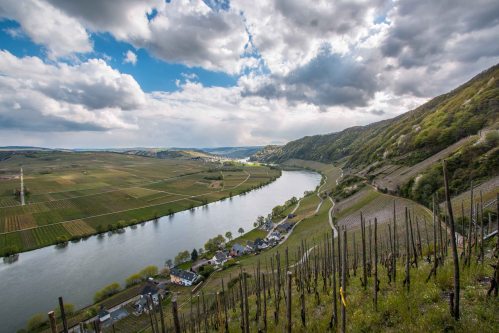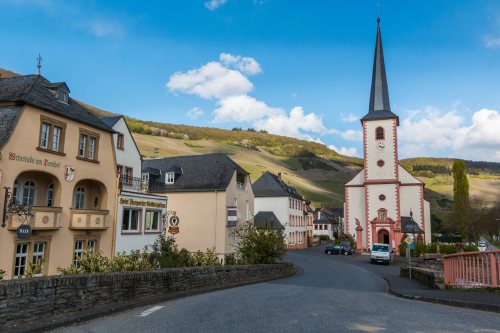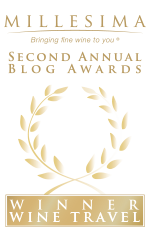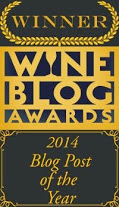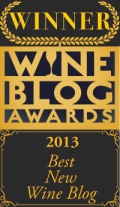Originally published in USA Today on August 18, 2016.
Seeking security, my right hand grasped at the nearest wooden pale as my left foot slid on the loose slate. I needed to stretch my camera two more inches beyond another row of stakes, each one supporting a heart-shaped Riesling vine, to get a clean shot of the valley.
I risked more than my dignity by dangerously leaning over the steep crest of the Mosel Valley’s fabled Piesporter Goldtröpfchen vineyards. Below, the region’s namesake river slipped around a wide curve with such stillness and grace, it appeared a watercolor of dappled blue and green. The quaint village of Piesporter straddled the bend, another fixed detail of the still life fanned out before me. The scene deserved the skill of a painter’s hand, not me and a Canon 70D, I thought.
Showstopping scenery abounds throughout Germany’s wine regions. Minimal development keeps the countryside bucolic; combined with the classic architecture and fachwerk homes (timber-framed), the effect transports visitors to another century. The other recurring theme across all thirteen appellations or anbaugebiete (“ahn-baw-jeh-beet”): Riesling. Deutschland serves as the spiritual home for the noble white grape, which accounts for almost a quarter of all plantings. The wines come in various styles from dry, off-dry, to sweet, and a range of quality levels. (Tip: Look for the acronym VDP with an eagle logo on the capsule. It designates a wine from a members only association committed to high farming and winemaking standards.)
However, climate change and the domestic predilection for red wine has given rise to black grape plantings, notably Pinot Noir (aka Spätburgunder.) A relative secret outside of Europe due to small production levels, Germany’s Pinot competes with the finest from Burgundy (and Switzerland). So, book your flight to Frankfurt and bring an empty suitcase; these three regions should top any first time visitor’s list.
Pfalz
Located in the far southwest corner, Pfalz, by German standards, boasts balmy weather. The climate favors a range of agricultural products like almonds, and citrus trees, as well as grapes. All those warm, sunshine days translate into bigger, more opulent wines with Riesling generally fermented dry. The region is a wine tourist’s paradise that few Americans have tapped into. It’s easy to navigate around the rolling, vine-covered hills. Wineries, open daily, are commonly staffed with English speakers and often have leafy, outdoor restaurants attached.
Base yourself in the cute village of Deidesheim, about 90 minutes driving from Frankfurt. There are several tasting rooms in town, relieving visitors of driving duty.
Weingut Von Winning
Walk from your hotel to the winery for a tasting, then stay for dinner at the excellent tavern called Leopold. If the weather cooperates, opt for a seat outdoors on the patio. Their wines have good distribution across the U.S., so don’t feel compelled to squirrel away bottles in your luggage. Von Winning takes the unique tack of fermenting its grand crus in oak. While the top wines can get expensive, the basic, delicious Win Win Riesling is affordable at less than $15. VDP member.
Weingut Markus Schneider
Markus Schneider has eschewed the heavy, nay somber interiors of classic German homes for modern, airy, and sleek. And that dismissal of tradition extends to his contemporary branding and gregarious personality, all of which nearly steal the spotlight from this striking project’s wines. If he’s on-site, feel free to engage with him on topics such as food, travel, and naturally, wine. Whether he’s a marketing genius or giving the people what they want, his atypically bold reds, especially the Syrah, have been wildly successful.
Reichsrat von Buhl
Founded 150 years ago, von Buhl Rieslings were served at the opening of the Suez Canal in 1869. Today, the estate bottled wines are made from organically farmed grapes in a bone-dry style, which you can sample by walking to the historic winery (open daily) from your hotel in town. Don’t miss the sparkling wine Germans call Sekt. VDP member.
Rheinhessen
Rheinhessen sports a roster of the country’s most dazzling winemakers. With a focus on dry Riesling, Pinot Noir, and Pinot Blanc (called Weissburgunder), a young group of open-minded, quality-driven producers helped stage the appellation’s resurgence with critics and collectors. While the prized red soils of the Roter Hang were once the dominant source of Rheinhessen’s top wines, good juice now can be found throughout. Two names to know — Wittman and Keller – make some of the most sought after bottles. Keller doesn’t sell at the cellar door, so consult wine shops or restaurants for his small production (and expensive) Riesling and Pinot Noir.
Weingut Wittman
A local leader partially responsible for reviving the legacy of quality winemaking in Rheinhessen, Philipp Wittman’s reputation doesn’t preclude access to his wines by wine lovers of modest means. Tastings of the biodynamic line-up occur in a modern facility off a garden oasis, and can be had by anyone, by appointment. His entry-level Gutsriesling is a great value, as well as introduction to the Wittman style, at less than 20 Euros. VDP member.
Weingut Dreissigacker
Former apprentice to icon Klaus-Peter Keller, the current proprietor of Dreissigacker, Jochen took over this family winery in 2001. He instituted critical changes, most notably converting the estate to organic viticulture. He is another example of Rheinhessen’s current generation of quality-over-quantity focused vintners. Taste through his well-priced range of dry Rieslings in the winery’s stylish tasting room in Bechtheim, by appointment.
Weingut Schätzel
Step into the depths of Kai Schätzel’s centuries-old cellar, and smell the fragrance of history clinging to the damp earth and walls. Many vintages of Rheinhessen Riesling have passed through this room, and an earnest Schätzel will regale guests with stories of his family’s winemaking past. Kai, however, took over in 2008, raising quality and earning entry into the prestigious VDP. Tastings are conducted by appointment in the dark-timbered main house, appointed in traditional Germanic décor.
Mosel Valley
At some point during a first trip to the Mosel, you’ll wonder if people actually live there. It has a quaint, quiet movie set perfection. And due to its cool location at 50 degrees latitude, Mosel is one of the northernmost quality wine regions in the world. But yes, people reside in the Valley and have made wine in it for nearly two millennia, since land-grabbing Roman conquerors spread cultivated grapevines to its slate-rich soils. In fact, the locations of recently excavated Roman presses discovered along the river, coincide with today’s top growing sites. The namesake river has two tributaries, the Saar and Ruwer. All three valleys produce delicate, aromatic, and vivid wines, often enhanced by a touch of sugar. As reward for their singular character, Mosel Rieslings accompany Bordeaux and Burgundy in the cellars of prestigious restaurants.
Weingut St. Urbans-Hof
Nik Weis, third generation vintner, has become a global ambassador for the Valley, traveling regularly to educate and promote Mosel wines. But his tasting room and winery in Leiwen remain open, even when he’s on the road. While he produces a variety of dry Rieslings, he believes Mosel wine has an inherent affinity for a cushion of residual sugar, and makes several examples dedicated to that style. Because the region’s Riesling has naturally high acidity, a touch of sugar serves to soften the sharpness, not make it taste sweet. VDP member.
Weingut Carl Loewen
A father and son run this family winery founded in 1803. Based out of a modest property in Leiwen (not far from St. Urbans-Hof), guests can make an appointment to taste Riesling from some of the oldest vineyards in the world. Production hits the 8000 case mark, and the wines are imported into the U.S., but they are hard to find outside major cities. Definitely save room in your luggage for a few bottles, especially the “1896”. This Riesling, named after the year the vines were planted, is made in a style akin to methods used during that time.
Dr. Loosen
Family-owned for over two-hundred years, the Dr. Loosen estate owns some of the finest, ungrafted, old vine sites in the Middle Mosel Valley, with six of its holdings equating to grand cru, or Grosse Lage quality. The current owner, Ernst Loosen, is building a beautiful new tasting room addition to the main house outside of Bernkastel. It should open to visitors this fall. In the meantime, tastings are available by appointment, booked via the website. Try to sample the small production “Reserve” line, denoting dry Riesling from top sites subject to extended aging. VDP member.
Mosel Valley Hotels
In the Countryside
Landhaus St. Urban
If you’re eager to enjoy more Nik Weis Riesling over an elegant dinner in the countryside, book a table at Rüssel’s Landhaus. Run by his sommelier sister Ruth and her talented chef and husband Harald Rüssel, the duo turns out gorgeous plates of locally-inspired fare paired to regional wines in a converted mill. Enjoy the terrace in the summer or sit inside the chic, recently renovated dining room. If you over-indulge, make a reservation at the adjoining hotel. The rooms are simple, but the scenery is the star anyway.
Near the Vineyards
Weinromantikhotel Richtershof
Near the banks of the Mosel River on the site of a winery dating from the 1600s, sits this mid-size, old-fashioned property. The floral motif in a pastel palette may evoke your grandmother’s notion of romantic décor, but its dated sensibility works in the setting. Several restaurants including a bistro bar, and an upscale dining room replete with wine cellar, keep guests busy after a day at the Roman-style spa and beauty salon.
In The Town of Bernkastel
Märchenhotel
Occasionally, you’ll want to dine in town and walk home rather than drive (because wine.) The village of Bernkastel-Kues offers a good selection of restaurants, wine bars, and time-capsule scenery without feeling garishly touristy. Towards the back of the Bernkastel-side and along the wall where the vineyards begin, is the Märchenhotel. The half-timbered, boutique property dates back to 1640. Room are decorated individually, each with a fairytale theme. (Märchen means folk- or fairy-tale.)

